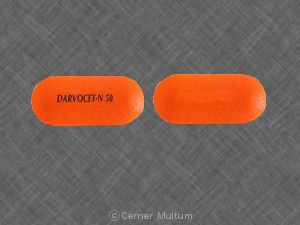Darvocet-N 50 and Alcohol/Food Interactions
There is 1 alcohol/food/lifestyle interaction with Darvocet-N 50 (acetaminophen / propoxyphene).
Propoxyphene Food/Lifestyle
Major Food Interaction
Consumer information for this interaction is not currently available.
GENERALLY AVOID: Alcohol may have additive CNS- and/or respiratory-depressant effects with propoxyphene. Misuse of propoxyphene, either alone or in combination with other CNS depressants, has been a major cause of drug-related deaths, particularly in patients with a history of emotional disturbances, suicidal ideation, or alcohol and drug abuse. Concomitant use may result in additive CNS depression and impairment of judgment, thinking, and psychomotor skills. In more severe cases, hypotension, respiratory depression, profound sedation, coma, or even death may occur.
GENERALLY AVOID: Grapefruit or grapefruit juice may increase the plasma concentrations of propoxyphene by inhibiting its CYP450 3A4-mediated metabolism, although the interaction has not been studied. In general, the effect of grapefruit juice is concentration-, dose- and preparation-dependent, and can vary widely among brands. Certain preparations of grapefruit juice (e.g., high dose, double strength) have sometimes demonstrated potent inhibition of CYP450 3A4, while other preparations (e.g., low dose, single strength) have typically demonstrated moderate inhibition. Pharmacokinetic interactions involving grapefruit juice are also subject to a high degree of interpatient variability, thus the extent to which a given patient may be affected is difficult to predict. In addition, high serum levels of propoxyphene have been associated with QT interval prolongation and torsade de pointes arrhythmia.
MANAGEMENT: Patients should not consume alcoholic beverages or use drug products that contain alcohol during treatment with propoxyphene. Any history of alcohol or illicit drug use should be considered when prescribing propoxyphene, and therapy initiated at a lower dosage if necessary. Patients should be closely monitored for signs and symptoms of sedation, respiratory depression, and hypotension. Given the interindividual variability in the pharmacokinetics of propoxyphene, a significant interaction with grapefruit juice in certain patients cannot be ruled out. Patients should be advised to seek immediate medical attention if they experience symptoms that could indicate the occurrence of torsade de pointes such as dizziness, lightheadedness, fainting, palpitation, irregular heart rhythm, shortness of breath, or syncope.
Switch to professional interaction data
Darvocet-N 50 drug interactions
There are 727 drug interactions with Darvocet-N 50 (acetaminophen / propoxyphene).
Darvocet-N 50 disease interactions
There are 19 disease interactions with Darvocet-N 50 (acetaminophen / propoxyphene) which include:
- alcoholism
- liver disease
- impaired GI motility
- infectious diarrhea
- prematurity
- acute alcohol intoxication
- drug dependence
- hypotension
- intracranial pressure
- respiratory depression
- gastrointestinal obstruction
- PKU
- adrenal insufficiency
- liver disease
- renal dysfunction
- seizure disorders
- urinary retention
- arrhythmias
- biliary tract disease
More about Darvocet-N 50 (acetaminophen / propoxyphene)
- Darvocet-N 50 consumer information
- Check interactions
- Compare alternatives
- Reviews (4)
- Drug images
- Side effects
- Dosage information
- During pregnancy
- Drug class: narcotic analgesic combinations
Related treatment guides
Drug Interaction Classification
| Highly clinically significant. Avoid combinations; the risk of the interaction outweighs the benefit. | |
| Moderately clinically significant. Usually avoid combinations; use it only under special circumstances. | |
| Minimally clinically significant. Minimize risk; assess risk and consider an alternative drug, take steps to circumvent the interaction risk and/or institute a monitoring plan. | |
| No interaction information available. |
See also:
Further information
Always consult your healthcare provider to ensure the information displayed on this page applies to your personal circumstances.


